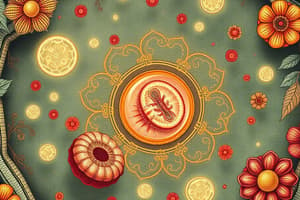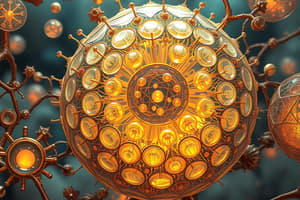Podcast
Questions and Answers
Which organelle plays a role in intracellular digestion?
Which organelle plays a role in intracellular digestion?
- Lysosome (correct)
- Chloroplast
- Ribosome
- Plasmodesma
_____ are surface appendages that allow a bacterium to stick to a surface.
_____ are surface appendages that allow a bacterium to stick to a surface.
Fimbriae
What is the function of a bacterium's capsule?
What is the function of a bacterium's capsule?
- Adhesion
- Protection (correct)
- DNA Storage
- Protein Synthesis
Where is a bacterial cell's DNA found?
Where is a bacterial cell's DNA found?
In a bacterium, where are proteins synthesized?
In a bacterium, where are proteins synthesized?
What name is given to the rigid structure, found outside the plasma membrane, that surrounds and supports the bacterial cell?
What name is given to the rigid structure, found outside the plasma membrane, that surrounds and supports the bacterial cell?
The _____ is the bacterial structure that acts as a selective barrier, allowing nutrients to enter the cell and wastes to leave the cell.
The _____ is the bacterial structure that acts as a selective barrier, allowing nutrients to enter the cell and wastes to leave the cell.
Which of the following clues would tell you if a cell is prokaryotic or eukaryotic?
Which of the following clues would tell you if a cell is prokaryotic or eukaryotic?
Which of the following correctly matches an organelle with its function?
Which of the following correctly matches an organelle with its function?
All of the following are part of a prokaryotic cell except
All of the following are part of a prokaryotic cell except
Which of the following is a major cause of the size limits for certain types of cells?
Which of the following is a major cause of the size limits for certain types of cells?
Beginning within the nucleus, the first step leading to the synthesis of a polypeptide is _____.
Beginning within the nucleus, the first step leading to the synthesis of a polypeptide is _____.
Which statement correctly describes the nuclear envelope of a eukaryotic cell?
Which statement correctly describes the nuclear envelope of a eukaryotic cell?
Large numbers of ribosomes are present in cells that specialize in producing which of the following molecules?
Large numbers of ribosomes are present in cells that specialize in producing which of the following molecules?
A cell with a predominance of free ribosomes is most likely
A cell with a predominance of free ribosomes is most likely
Which structure is the site of the synthesis of proteins that may be exported from the cell?
Which structure is the site of the synthesis of proteins that may be exported from the cell?
Which one of the following statements about the endomembrane system is correct?
Which one of the following statements about the endomembrane system is correct?
The liver is involved in detoxification of many poisons and drugs. Which of the following structures is primarily involved in this process and therefore abundant in liver cells?
The liver is involved in detoxification of many poisons and drugs. Which of the following structures is primarily involved in this process and therefore abundant in liver cells?
Which type of organelle or structure is primarily involved in the synthesis of oils, phospholipids, and steroids?
Which type of organelle or structure is primarily involved in the synthesis of oils, phospholipids, and steroids?
The Golgi apparatus has a polarity or sidedness to its structure and function. Which of the following statements correctly describes this polarity?
The Golgi apparatus has a polarity or sidedness to its structure and function. Which of the following statements correctly describes this polarity?
Hydrolytic enzymes must be segregated and packaged to prevent general destruction of cellular components. In animal cells, which of the following organelles contains these hydrolytic enzymes?
Hydrolytic enzymes must be segregated and packaged to prevent general destruction of cellular components. In animal cells, which of the following organelles contains these hydrolytic enzymes?
Which of the following produces and modifies polysaccharides that will be secreted?
Which of the following produces and modifies polysaccharides that will be secreted?
Which of the following contains hydrolytic enzymes?
Which of the following contains hydrolytic enzymes?
Which organelle often takes up much of the volume of a plant cell?
Which organelle often takes up much of the volume of a plant cell?
Mitochondria are found in _____.
Mitochondria are found in _____.
Which of the following are common traits of chloroplasts and mitochondria?
Which of the following are common traits of chloroplasts and mitochondria?
A cell has the following molecules and structures: enzymes, DNA, ribosomes, plasma membrane, and mitochondria. It could be a cell from
A cell has the following molecules and structures: enzymes, DNA, ribosomes, plasma membrane, and mitochondria. It could be a cell from
Which organelle is the primary site of ATP synthesis in eukaryotic cells?
Which organelle is the primary site of ATP synthesis in eukaryotic cells?
Which animal cell organelle contains enzymes that transfer hydrogen from various substrates to oxygen?
Which animal cell organelle contains enzymes that transfer hydrogen from various substrates to oxygen?
In a plant cell, DNA may be found
In a plant cell, DNA may be found
The chemical reactions involved in respiration are virtually identical between prokaryotic and eukaryotic cells. In eukaryotic cells, ATP is synthesized primarily on the inner membrane of the mitochondria. In light of the endosymbiont theory for the evolutionary origin of mitochondria, where is most ATP synthesis likely to occur in prokaryotic cells?
The chemical reactions involved in respiration are virtually identical between prokaryotic and eukaryotic cells. In eukaryotic cells, ATP is synthesized primarily on the inner membrane of the mitochondria. In light of the endosymbiont theory for the evolutionary origin of mitochondria, where is most ATP synthesis likely to occur in prokaryotic cells?
The evolution of eukaryotic cells most likely involved
The evolution of eukaryotic cells most likely involved
Which of these cell junctions form a barrier to the passage of materials?
Which of these cell junctions form a barrier to the passage of materials?
The primary role of _____ is to bind animal cells together.
The primary role of _____ is to bind animal cells together.
Select the correct statement describing cellular structure or function.
Select the correct statement describing cellular structure or function.
Identify the correct statement about differences between rough and smooth endoplasmic reticulum (ER).
Identify the correct statement about differences between rough and smooth endoplasmic reticulum (ER).
Ions can travel directly from the cytoplasm of one animal cell to the cytoplasm of an adjacent cell through
Ions can travel directly from the cytoplasm of one animal cell to the cytoplasm of an adjacent cell through
_____ aid in the coordination of the activities of adjacent animal cells.
_____ aid in the coordination of the activities of adjacent animal cells.
What do the cell walls of plants and the extracellular matrix of animal cells have in common?
What do the cell walls of plants and the extracellular matrix of animal cells have in common?
Plasmodesmata in plant cells are most similar in function to which of the following structures in animal cells?
Plasmodesmata in plant cells are most similar in function to which of the following structures in animal cells?
Flashcards
Lysosome
Lysosome
Intracellular digestion; contains hydrolytic enzymes to break down waste.
Ribosomes
Ribosomes
Sites of protein creation; abundant in cells secreting proteins.
Chloroplast
Chloroplast
Site of photosynthesis in plant cells.
Fimbriae
Fimbriae
Signup and view all the flashcards
Capsule (Bacterial)
Capsule (Bacterial)
Signup and view all the flashcards
Nucleoid Region
Nucleoid Region
Signup and view all the flashcards
Cell Wall (Bacterial)
Cell Wall (Bacterial)
Signup and view all the flashcards
Endomembrane System
Endomembrane System
Signup and view all the flashcards
Nuclear Envelope
Nuclear Envelope
Signup and view all the flashcards
Mitochondria
Mitochondria
Signup and view all the flashcards
DNA to mRNA Transfer
DNA to mRNA Transfer
Signup and view all the flashcards
Rough ER
Rough ER
Signup and view all the flashcards
Smooth ER
Smooth ER
Signup and view all the flashcards
Golgi Apparatus
Golgi Apparatus
Signup and view all the flashcards
Surface Area to Volume Ratio
Surface Area to Volume Ratio
Signup and view all the flashcards
Free Ribosomes
Free Ribosomes
Signup and view all the flashcards
Tight Junctions
Tight Junctions
Signup and view all the flashcards
Gap Junctions
Gap Junctions
Signup and view all the flashcards
Prokaryotic Characteristics
Prokaryotic Characteristics
Signup and view all the flashcards
Eukaryotic Traits
Eukaryotic Traits
Signup and view all the flashcards
Endosymbiotic Theory
Endosymbiotic Theory
Signup and view all the flashcards
Plasmodesmata vs. Gap Junctions
Plasmodesmata vs. Gap Junctions
Signup and view all the flashcards
ECM and Plant Cell Walls
ECM and Plant Cell Walls
Signup and view all the flashcards
ATP Synthesis
ATP Synthesis
Signup and view all the flashcards
Hydrolytic Enzymes
Hydrolytic Enzymes
Signup and view all the flashcards
Study Notes
Organelles and Their Functions
- Lysosome: Involved in intracellular digestion, containing hydrolytic enzymes that break down waste materials.
- Ribosomes: Sites of protein synthesis within a cell, present abundantly in cells producing proteins for secretion.
- Chloroplast: Not found in animal cells, responsible for photosynthesis in plant cells.
- Fimbriae: Surface appendages on bacteria that allow attachment to surfaces.
Bacterial Cell Structure
- Capsule: Provides protection to bacterial cells, aiding in their survival against environmental stresses.
- Nucleoid Region: Area where bacterial DNA is located, devoid of a membrane-bound nucleus.
- Cell Wall: A rigid structure providing support and shape to bacterial cells.
Eukaryotic Cell Characteristics
- Endomembrane System: Comprises various membranes including the nuclear envelope, endoplasmic reticulum (ER), and Golgi apparatus, involved in protein and lipid synthesis and processing.
- Nuclear Envelope: Composed of two membranes; continuous with the endoplasmic reticulum.
- Mitochondria: Known as the powerhouses of the cell, sites for ATP production and energy metabolism.
Genetic Information and Protein Synthesis
- DNA to mRNA Transfer: The first step in polypeptide synthesis occurs in the nucleus where DNA is transcribed into messenger RNA.
- Proteins: Synthesized either for use within the cell or for export; rough ER is specifically involved in the synthesis of proteins intended for secretion.
Organelles in Metabolism
- Smooth ER: Involved in the synthesis of lipids, steroids, and detoxification processes.
- Golgi Apparatus: Modifies, sorts, and packages proteins and polysaccharides for secretion or use within the cell.
Cell Size and Function
- Surface Area to Volume Ratio: Limits cell size; cells must maintain sufficient surface area to meet metabolic demands.
- Free Ribosomes: Indicate the production of cytoplasmic proteins, not destined for export.
Cellular Connections and Communication
- Tight Junctions: Create barriers to material passage between cells, maintaining distinct tissue environments.
- Gap Junctions: Allow direct communication and transfer of ions between adjacent animal cells, facilitating coordinated activities.
Distinguishing Eukaryotic and Prokaryotic Cells
- Prokaryotic Characteristics: Lack of organelles such as endoplasmic reticulum; bacterial cells do not contain a nucleus or complex organelles.
- Eukaryotic Traits: More complex with membrane-bound organelles responsible for specific cellular functions.
Evolutionary Perspectives
- Endosymbiotic Theory: Suggests that mitochondria and chloroplasts originated from free-living prokaryotes that entered into a symbiotic relationship with ancestral eukaryotic cells.
Cellular Structures and Their Shared Functions
- Plasmodesmata in Plants vs. Gap Junctions in Animals: Both facilitate cell communication and transport of materials across adjacent cells.
- Extracellular Matrix and Plant Cell Walls: Provide structural support while allowing for communication with the cell's cytoskeleton.
Key Concepts in Cellular Respiration and Energy
- ATP Synthesis: Primarily occurs in mitochondria of eukaryotic cells, with prokaryotic cells synthesizing ATP on the plasma membrane.
- Hydrolytic Enzymes: Found in lysosomes, crucial for breaking down cellular components and waste.
These notes encapsulate the vital functions and structures of cellular organelles while drawing comparisons between different cell types, aiding in understanding the fundamental concepts of cellular biology.
Studying That Suits You
Use AI to generate personalized quizzes and flashcards to suit your learning preferences.




